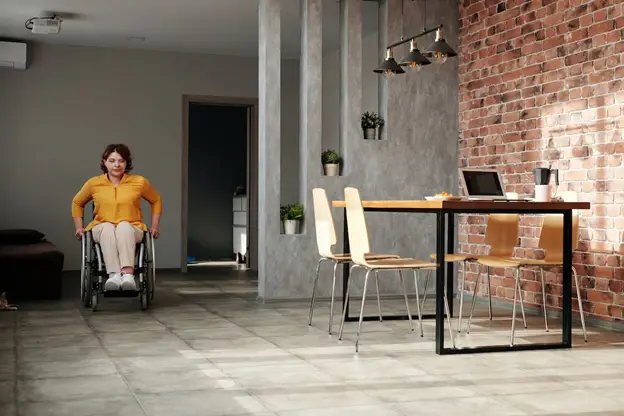
How to Safely Help a Fallen Loved One: Guidance for Emergency Contacts
How to Safely Help a Fallen Loved One: Guidance for Emergency Contacts In moments of urgency, knowing how to assist a loved one who has
From Blueprint to Reality: Your Guide to Building an Accessible Home

Creating a home that is accessible and inviting for everyone can be a complex task. However, with a well-thought-out strategy and meticulous planning, you can design a living space accommodating all needs. This guide will walk you through the steps involved in building an accessible home in Australia, ensuring comfort and ease for everyone. It’s more than just creating a space; it’s about crafting an environment that’s inclusive and welcoming for everyone.
The first critical step towards building an accessible home is gaining a comprehensive understanding of the accessibility requirements as defined by Australian standards. These guidelines consider various factors such as door width, ramp gradients, and the height of light switches. It’s equally important to understand that different disabilities necessitate unique modifications. Resources like the Australian Network on Disability offer valuable insights about these standards, helping you to design a home that caters to everyone’s needs. Familiarizing yourself with these standards ensures you can make informed decisions when designing your home.
The physical location of your home greatly influences its accessibility. It’s beneficial to select a location that provides easy access to essential services, including hospitals, grocery stores, and public transportation. The geographical terrain of the location also matters; flat land is more accommodating for individuals using wheelchairs or those with mobility issues. Consideration of these aspects ensures the home’s surroundings complement its accessible design. A well-located home can dramatically enhance the lifestyle of its residents, ensuring they have convenient access to necessary services. Moreover, a suitable location adds value to your property, making it a wise investment in the long run.
In terms of architectural design, single-story homes are often more conducive to accessibility. They eliminate the need for stairs, which can be a significant obstacle for individuals with mobility challenges. However, in cases where a multi-story home is necessary, incorporating a residential elevator or stair lift that aligns with Australia’s Home Lift Standards can be a practical solution. This ensures every level of your home remains accessible. Single-story homes, or multi-story homes with appropriate modifications, ensure that all residents can navigate their homes with ease.
The type of flooring used can significantly impact the accessibility of your home. It’s best to opt for slip-resistant materials such as vinyl or textured tiles, which reduce the risk of falls. High-pile carpets, which can obstruct the movement of wheelchairs and walkers, should ideally be avoided. A careful choice of flooring ensures safer navigation within the home. The right flooring can add to the aesthetic appeal of your home while ensuring it remains safe and accessible. It can be the difference between a home that looks good and a home that feels good.
An accessible bathroom is an essential feature of any accessible home. Key modifications include installing grab bars near the toilet and shower area, opting for a roll-in shower or walk-in tub, and considering a raised toilet seat. The sink should also be wheelchair-friendly. Guidelines provided by Livable Housing Australia can be a valuable resource when designing accessible bathrooms, ensuring ease and safety. An accessible bathroom goes a long way in ensuring the comfort and dignity of all residents. Plus, it adds to the overall functionality and convenience of your home.
The task of building an accessible bathroom requires specialized expertise. If you’re considering bathroom renovations, it’s crucial to engage licensed contractors who possess a deep understanding of accessibility design and can deliver high-quality workmanship. Their expertise can guide you in realizing your vision of an accessible home. To take the guesswork out of the process, look for a contractor who offers a 3D design proposal.
Adequate lighting plays a pivotal role in catering to individuals with visual impairments. It’s crucial to ensure all areas of your home, particularly stairways, and bathrooms, are well-lit. Automatic lights that turn on upon detecting movement can be a helpful addition, enhancing visibility and safety. Good lighting not only aids visibility but also creates a warm and inviting atmosphere in your home. It enhances the aesthetic appeal of your space, making it feel more homely and comfortable.
Innovative home products can dramatically enhance the accessibility of your home. Voice-activated devices, automated door openers, and smart thermostats that can be controlled via smartphones are just a few examples of such technologies. These innovative solutions can add a layer of convenience and autonomy to daily living. With advances in technology, the possibilities for innovative home features are expanding, making life easier for everyone in the home. It’s a worthwhile investment that can enhance the quality of life for all residents. Before procuring any products, it’s wise to tap into online resources for product reviews and recommendations.
Building an accessible home in Australia is a significant undertaking that promises substantial rewards. It paves the way for an enhanced quality of life for those with disabilities. By adhering to this guide and working with a highly rated bathroom renovation contractor, you are well-equipped to create a home that is not only safe and comfortable but genuinely accessible for all. Building an accessible home is not just about ticking boxes; it’s about creating a space where everyone can live comfortably and independently.



How to Safely Help a Fallen Loved One: Guidance for Emergency Contacts In moments of urgency, knowing how to assist a loved one who has

Discover how a senior safety check-in service like CareCallingNow ensures daily well-being checks, offering peace of mind for families.

Stay Safe Anywhere: The Ultimate Guide to Personal Alert Safety Systems In a world where unpredictability lurks around every corner, personal safety is paramount. Whether

ⓒ All rights reserved